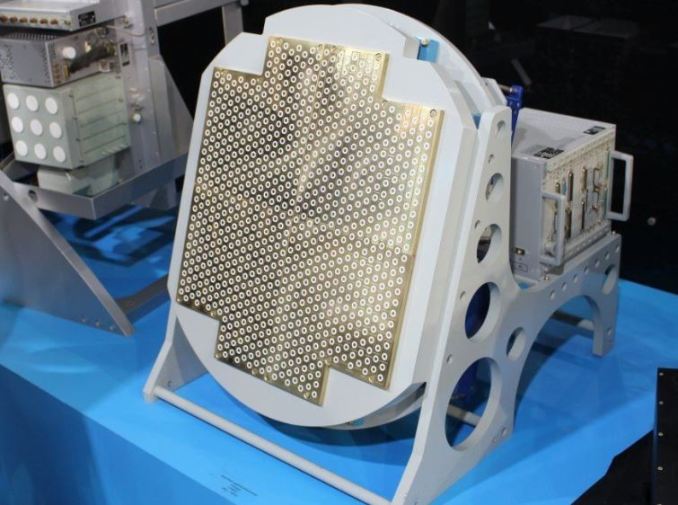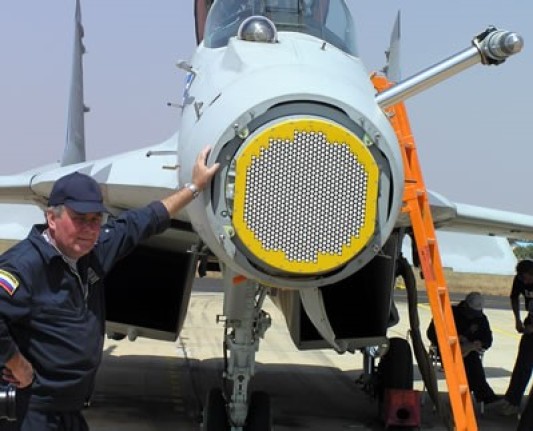

Zhuk-MSFEh
The Russia’s Phazotron-NIIR Corp. claims that it has the newly built Phazatron Zhuk AESA radar system. This is the first AESA of Russian origin.
The 600-mm.-dia. (24-in.) Prototype radar with 680 transmit/receive (TR) modules has been tested on a MiG-35 since 2008. Fight tests verified its operating range against air and ground targets and in ground-mapping modes. The prototype has a detection range of 60-65 km. (37-40 mi.).
The radar is yet to be proven its countermeasures capability. The radar can only detect incoming fighters at least from 50 km and outgoing fighters at least from 90 km. It can also detect a tank at 20 km. The production variant of radar may be able to detect 30 targets at a range of 130 km in the air and 300 km in water, and can engage with 6 targets at a time.
The ZHUK AE is the first Russians AESA and has been fitted to the MiG 35 prototype being offered to India as their new “low” capability fighter to complement their “high” capability SU-30MKI. Zhuk-AME AESA radar is yet to be integrated with MiG-35due to the overheating issues of Russian-made AESA radar.
IHS Janes reported that the Zhuk-AME radar will be tested until the year 2020 if the current funding is not withdrawn. Russia is currently facing financial crisis and defence budget is already stretched for ballistic missile program,–there is no guarantee that Russia will continue to fund Zhuk trials knowing that there is a little prospect of exporting Zhuk radar with MiG or Sukhoi.
The Zhuk Radar is quite small, and there would have to be cooling constraints in the smaller nose cone. Given these limitations and the immaturity of the system, you could assume it would still be quite inferior to western and other Russian radars in all parameters.
The radar uses multiple four channel transceivers modules generating an output of 5watt per channel, installed on a liquid cooled base plate to dissipate the generated heat. If a specific transceiver is overheated, it will be switched off by the radar computer until it cools down.
Zhuk-MSFEh Variant
Ground Tests of “Zhuk-MSFEh” Aircraft Radar Completed. The Phazotron-NIIR corporation has completed laboratory and bench tests and also revision of the new “Zhuk-MSFEh”aircraft radar (BRLS).
The Zhuk-MSFEh BRLS has passed bench tests, having confirmed all estimated data and characteristics. During the tests, the software is yet to be debugged, and environmental tests of the blocks were performed, an informed source in the defense industrial complex reported to Interfax-AVN on November 2018.

According to the estimated data, the “Zhuk-MSFEh” should detect and simultaneously track over 24 airborne targets and provide simultaneous firing at up to 8 of them. The new radar has a completely new configuration and architecture for building the passive antenna array.
Having passed the ground tests, the “Zhuk-MSFEh” is intended for installation on fighters of the Sukhoi firm, has a phased antenna array and has been developed for export (MSFEh is stand for Modified,Sukhoi, Phased, Export), the IF-AVN source explained.
He reported that at the present time, three new BRLS are installed on Su-30MKK,Su-27IB and Su-25 airplanes.
Other variants include Zhuk-ME, Zhuk-MFE and Zhuk-MFSE.
© 2018 – 2019, LM Publications. © GDC and www.globaldefensecorp.com. Unauthorized use and/or duplication of this material without express and written permission from this site’s author and/or owner is strictly prohibited. Excerpts and links may be used, provided that full and clear credit is given to www.globaldefensecorp.com with appropriate and specific direction to the original content.






Be the first to comment